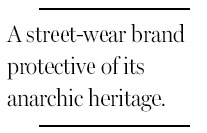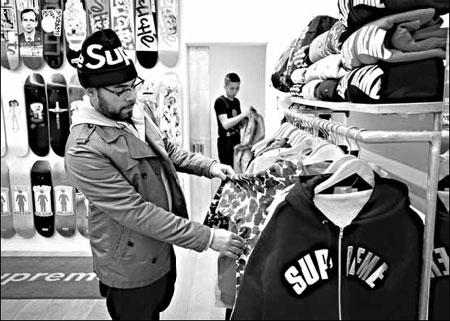The guerrilla way to brand success
Updated: 2013-02-24 07:53
By Alex Williams(The New York Times)
|
|||||||
|
Supreme streetwear, merging under-ground styles, is drawing customers in Los Angeles, London and Tokyo. A shopper at its store in Manhattan. Deidre Schoo for The New York Times |

In certain urban circles, a new line from Supreme, the cultish street-wear brand, qualifies as an event, on par with a new iPhone. Fans camp out on folding chairs and sleeping bags.
For much of its 18-year existence, Supreme was confined to the in-crowd, a scruffy clubhouse for a select crew of pot-smoking skate urchins, graffiti artists, underground filmmakers and rappers. Now, Supreme has been embraced by a new global tribe eager to crack its code.
Huge lines, once endemic to its New York flagship in SoHo, now form at satellite stores in Los Angeles, London, Tokyo and other cities. British GQ Style, a men's fashion bible, hails Supreme as "the coolest streetwear brand in the world right now." And the Berlin culture magazine O32c called it "the Holy Grail of high youth street culture." The Business of Fashion site called it "the Chanel of downtown streetwear."
At Paris Fashion Week in the fall, Kanye West arrived at the Celine show wearing a green-camouflage pullover field jacket by Supreme. In September, Frank Ocean performed on the satirical American television show "Saturday Night Live" wearing a Supreme hockey jersey adorned with a Southwestern-style thunderbird.
For any other brand, such sightings would be considered a public relations coup. But they are beside the point for Supreme, which is so fiercely protective of its anarchic downtown heritage that it would rather be ignored by the masses than misunderstood.
Supreme is a company that plays hard to get. "Most businesses just have a goal of getting as big as possible," said Glenn O'Brien, a style writer. But Supreme does not "try to be in every department store in the world," preferring to stay underground and boutique.
"Supreme is a company that refuses to sell out," he said.
Opened in 1994 by James Jebbia, the Lafayette Street store pioneered an art-gallery-cum-storage-facility chic, with its white walls and plywood shelving.
The retail experience - from the Bad Brains hardcore punk music blaring overhead, to the clerks who sized up visitors with blank stares - could be forbidding. Shoppers could look but not touch, especially during the early days, recalled Aaron Bondaroff, a founder of Ohwow gallery who worked at the shop in the 1990s. Anyone who mussed the T-shirts could expect a scolding.
The subtext was clear: One had to earn the right to shop there.
Supreme merges various underground style currents - the punkiness of skatewear, the macho utilitarianism of military gear, the brash colors of '80s hip-hop - into a singular aesthetic.
Prices are hardly astronomical (jeans are $130; hoodies, $170), but Supreme cultivates the same covetous frenzy that might greet a new $9,000 Hermes Birkin bag.
Limited runs help stoke demand. A corduroy shell jacket, a collaboration with North Face listed at $298, sold out in one minute online and appeared almost simultaneously on eBay for $700.
Collaborations with contemporary artists further enhance Supreme's esoteric air. The current fall-winter collection includes an Army-style M-51 jacket, featuring artwork by the skateboarder and artist Mark Gonzales, for $298. Skate-deck collaborations with artists like Damien Hirst and Richard Prince may retail for less than $100, but are "collected like art," Mr. O'Brien said.
The brand's mystique extends to its promotion. Supreme could be a case study on guerrilla marketing. Bumper stickers with its fiery-red logo are in bohemian neighborhoods around the globe - Harajuku, Tokyo; Shoreditch, London; Kreuzkolln, Berlin; Greenpoint, Brooklyn - like hobo signs for global cool hunters.
Its Web commercials, meanwhile, could double as art video installations. In one grainy spot, the rap group Three 6 Mafia hangs out in an underlighted room at the Chateau Marmont.
Supreme draws inspiration from sources as disparate as John Coltrane, Robert Longo, Malcolm McLaren and Public Enemy.
Mr. Jebbia, 48, is a quiet family man who grew up mainly in Sussex, England. He was never a skater. He insists he is not elitist about who wears Supreme. But he is loathe to water down the brand to cross over to the mainstream.
Big or small, the brands he admires - A.P.C., Polo, Isabel Marant, Antihero Skateboards - invented and maintained "a dope original and consistent design language," Mr. Jebbia said.
"I feel a very important factor to our longevity is that, over the years, we have managed to create our own unique identity and aesthetics," he added.
Staying true to Supreme code is the only business plan he has.
Supreme, as he put it, "needs to be cool to survive."
The New York Times
(China Daily 02/24/2013 page12)
